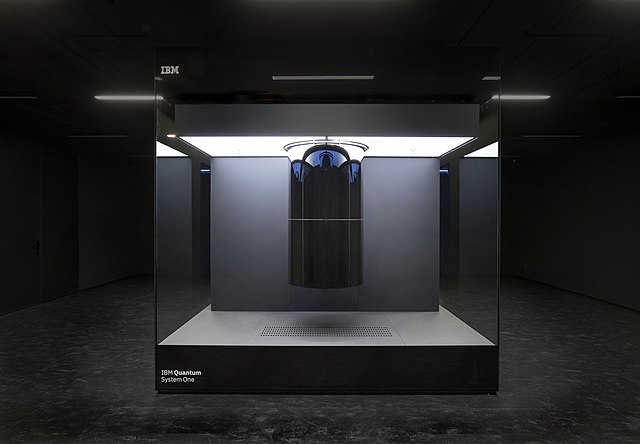
How does a quantum computer work? They use subatomic particles, which can exist in more than one state at the same time.
Regular computers are binary, which means everything they display or calculate is just a series of 0s and 1s. For example the word plasma, is 011100000110110001100001011100110110110101100001. A computer is made up of millions and millions of switches and these switches can either be in the off position, which is 0, or in the on position, which is 1. The first computers were literal switches, but today they are microscopic. The switches are called transistors and a computer’s processing unit (CPU) could have billions of transistors. The transistors are set into a chip and they are made out of semiconductors, which conduct electricity, but not very well. If the computer wants to display the word plasma, it passes electricity through some of the transistors to make the 1s and doesn’t pass electricity through the others, leaving them as 0s. This is very similar to semaphore, except much much faster. Semaphore is a visual method of signaling using flags or lights. Imagine you want to send the word plasma. You can’t make letters because you can only switch your light on or off. You agree an alphabet with the other person where a certain number of on lights and a certain number of on lights in a certain sequence make p. Then you flash the light on and off. A computer does exactly the same thing, except at a ridiculously fast speed.
The thing that limits computers is the number of transistors they can have. To make more powerful computers that do more calculations per second, you need more transistors. If a computer has a billion transistors, it can only have a billion on or offs at any one moment. However, there are more practical problems because all of this electricity creates heat. It is possible to put more transistors on a chip, but you need a way to remove the heat and that gets hard. It is one of the problems that bitcoin mining computers have. So, unless there is a new material used, or a new way of cooling the transistors invented, we may be getting close to the limit.
So, what is the solution. Well, that would be quantum computing. A quantum computer works by using something called a qubit. That stands for quantum bit. A quantum bit is a single particle, often an electron. Electrons have a magnetic field and they have north and south poles. These electrons can spin until they come into contact with another magnetic field and line up along it. When they stop spinning, they will either be pointing up or down in line with the other field, and this is known as their quantum state. In a quantum computer, this up or down position is used as the 1 and the 0 in a regular computer.
If that is all it is, quantum computers don’t sound so special. The interesting thing comes in because electrons exist in a state called superposition. That means the electron is in all possible positions at the same time. It is both up and down at the same time. When the electron is observed, the superposition state collapses, and the electron is found in one of the two states. That means, a single qubit can have a value of 0, and 1 at the same time. It is also possible to entangle these qubits so they all work together.
2 transistors on a regular computer can only have four possible positions. They could be 00, 01, 10, 11, which is 4 possibilities. 2 qubits could be all of these four states at the same time, only settling on two when they are observed. With 3 qubits, there are 8 possible states that they could be in. 000, 001, 010, 100, 101, 011, 110, 111. For 4 qubits, there are 16 states, for 5 qubits 32 states, and so on, increasing exponentially. The advantage to quantum computing comes in because they can be in all of these states at the same time. 5 transistors would have to cycle 32 times to go through all of the 32 possible combinations. 5 qubits would do it instantly. It wouldn’t take a computer long to do 32 calculations, but when we get up into the billions or trillions of calculations, this starts to make a difference. Quantum computers could perform in seconds calculations that would take regular computers thousands of years.
Quantum computers have a lot of problems though. First, qubits are very hard to make. Secondly, they have to be kept very close to absolute zero, which is very hard to do. Thirdly, the qubits have to be protected from the Earth’s magnetic field or anything that could interfere with them. And lastly, they need a lot of power. Quantum computers aren’t going to replace our computers, and they are not really intended to. Our computers are fine for what we use them for. Quantum computers will come in useful for analyzing enormous quantities of data in seconds. This will be vital for science, astronomy, medicine, mathematics, and hackers that want to crack impossible encryption. It will be interesting what happens.
Image By IBM Research – https://www.flickr.com/photos/ibm_research_zurich/51248690716/, CC BY 2.0, https://commons.wikimedia.org/w/index.php?curid=108205707
Sources
https://www.quora.com/When-will-we-reach-the-limit-to-how-many-transistors-a-CPU-can-have
https://builtin.com/hardware/transistor
https://medium.com/swlh/breaking-the-code-binary-letters-3a95bafa18f5
https://www.investopedia.com/terms/q/quantum-computing.asp
https://www.scientificamerican.com/video/how-does-a-quantum-computer-work
